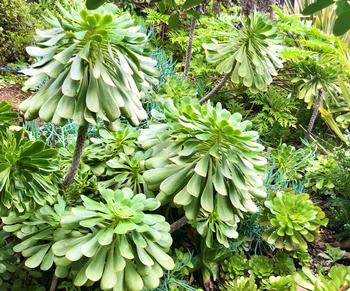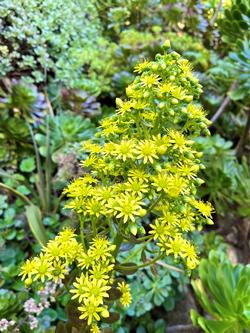Aeoniums, a Canary Island native that feels right at home in Marin
-
James Campbell
-
We hear the message Conserve Water a lot nowadays, and little wonder with another year of drought stressing our state. Conserving water is a principle of earth-friendly gardening and both North Marin Water District and Marin Municipal Water District encourage water conservation with their rate tier systems. No wonder interest in succulents is at an all-time high. My garden is full of Aeoniums, which are native to the Canary Islands and North Africa and thrive in Marin. There are approximately 35 varieties of Aeoniums, and they all grow one of two ways; either low-growing or those that employ a short trunk. The distinctive geometric circular leaf rosettes typical to all Aeoniums can be as small as four inches or as wide as two feet, depending on the variety. The rosette colors range from shades of green to variegated, eggplant, or nearly black. Aeoniums generally like sun or part shade in milder parts of Marin, but they will need some shade in hotter parts of the county. These subtropical succulents like good drainage.
 Aeoniums are succulents that come in all sorts of sizes. Photo: James CampbellFor me, the foliage is the main attraction of Aeoniums. Their oblong leaves look like big fleshy flowers. They do have real flowers, but most aeoniums are monocarpic, meaning that the mother plant dies after flowering, with offshoots of pups that can continue to live. Aeoniums are super easy to propagate. I just break a piece with a rosette off the mother plant and stick it in the ground wherever I want a new plant to grow. My garden must have a similar climate to the Canary Islands because my Aeoniums have naturalized and grown all over the place where the seeds have spread.
Aeoniums are succulents that come in all sorts of sizes. Photo: James CampbellFor me, the foliage is the main attraction of Aeoniums. Their oblong leaves look like big fleshy flowers. They do have real flowers, but most aeoniums are monocarpic, meaning that the mother plant dies after flowering, with offshoots of pups that can continue to live. Aeoniums are super easy to propagate. I just break a piece with a rosette off the mother plant and stick it in the ground wherever I want a new plant to grow. My garden must have a similar climate to the Canary Islands because my Aeoniums have naturalized and grown all over the place where the seeds have spread. Monocarpic succulent Aeoniums bloom just once in their lifespan. Photo: James Campbell
Monocarpic succulent Aeoniums bloom just once in their lifespan. Photo: James CampbellDue to their shallow root systems, aeoniums are not drought resistant, unlike most succulents, but they go into dormancy during the summer months. In my shady garden, they survive only on winter rains and are not on irrigation. This means I get two very different-looking gardens. In the winter, the garden looks lush and green, but in the summer months, the leaves curl up and shrink and look more like a dry garden.
Aeoniums store water in the fleshy leaves of the rosette to survive the hot, dry regions they come from. Like other succulents, Aeoniums avoid desiccation by only opening their stomata at night. Stomata are the leaf cells that release oxygen and take in carbon dioxide. The Aeoniums convert the carbon dioxide they take in at night into a four-carbon organic acid that is used during the day for photosynthesis. The term for this is crassulacean acid metabolism. The leaves we are most familiar with are relatively flat with mostly visible vein patterns. The leaves on succulents, like Aeoniums, are plump and filled with precious water. To maintain efficient photosynthesis requires an evolution of leaf vein structure from a two-dimensional model to something best described as three-dimensional.
 In the winter months in Marin, Aeoniums are lush green and fleshy; in summer Aeoniums shrink in size and turn darker colors. Photo: James Campbell
In the winter months in Marin, Aeoniums are lush green and fleshy; in summer Aeoniums shrink in size and turn darker colors. Photo: James CampbellThe name Aeonium comes from the ancient Greek word for ageless. This speaks to their ability to keep producing new plants and to last forever. So give a few of these whimsical succulents a try in your garden. Your water bill will thank you.



